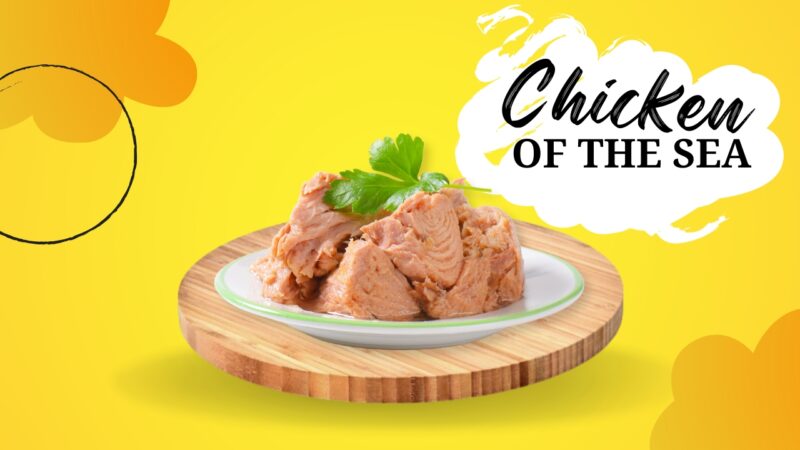When it comes to food nicknames, few are as ubiquitous or as interesting as the term “chicken of the sea”. A phrase most often associated with canned tuna, it has become a staple in many household pantries worldwide. But how did this moniker come about, and why is it so closely linked to a specific type of seafood?
While the mimic octopus has its unique ways of blending into the oceanic environment, the tuna, often referred to as the chicken of the sea, has its own fascinating tales and adaptations. Let’s dive in and explore the depths of this familiar term.
Brief History of the Term
The phrase “chicken of the sea” was first popularized in the early 20th century by the Van Camp Seafood Company, the original parent company of the brand Chicken of the Sea. They sought to create a way to describe the mild, white meat of albacore tuna in a way that was both appetizing and familiar to the American consumer.
Tuna was a relatively new addition to the American diet, and the company needed to establish it as a versatile, healthy, and accessible alternative to traditional poultry. By comparing the seafood to chicken, they hoped to communicate the idea that tuna was a safe and approachable choice, particularly for those who might be hesitant about trying seafood.
Meet the Chicken of the Sea: Tuna

Tuna, a saltwater fish found in warm seas, is indeed the seafood most commonly associated with the phrase “chicken of the sea”. There are many species of tuna, but the ones most frequently consumed include albacore, yellowfin, bigeye, bluefin, and skipjack.
Albacore, the original “chicken of the sea”, is known for its mild flavor and light color, closely resembling that of cooked chicken. These characteristics, along with its high protein content and omega-3 fatty acids, made it a popular choice for canned seafood. Over time, the term was extended to include other species of tuna as well, thanks to their similar culinary profiles.
Ocean’s Bounty: Sustainable Fishing
One of the reasons behind the continued popularity of canned tuna is its reputation as a more sustainable choice in seafood. Tuna is a fast-growing species with a widespread distribution, making it less susceptible to overfishing compared to other types of fish. However, the sustainability of tuna fishing is complex and depends on factors such as the fishing methods used, the specific tuna species, and the location of the fishery.
Modern tuna fisheries employ a range of techniques to reduce bycatch (the unintentional capture of non-target species) and to ensure the long-term viability of the tuna population. While no fishing method is perfect, it’s encouraging to see an increasing commitment to sustainability in the industry.
Tuna in Global Cuisine

Tuna’s status as the “chicken of the sea” extends beyond canned products and into global cuisine. In Japan, tuna is the star of sushi and sashimi, with different cuts prized for their unique flavors and textures. In Mediterranean countries, fresh or grilled tuna is often served with olive oil, lemon, and fresh herbs. In the United States, aside from the ever-popular tuna sandwich, tuna steaks are often seared or grilled, providing a healthy and delicious alternative to red meat.
Despite the variety in preparation methods, the versatile nature of tuna truly earns it its nickname. Much like chicken, it can be cooked in numerous ways, adapting well to different cooking methods and flavor profiles.
Health Benefits of the Sea’s Chicken
Tuna is not just versatile and tasty; it also packs a nutritional punch. High in lean protein, omega-3 fatty acids, and various vitamins and minerals, it’s a good choice for those seeking to maintain a balanced diet.
Omega-3 fatty acids, in particular, have been linked to numerous health benefits, including improved heart health, reduced inflammation, and better mental health. Meanwhile, the high-quality protein found in tuna is essential for maintaining muscle mass, boosting immunity, and promoting overall well-being.
Chicken of the Sea in Your Kitchen
Given its versatility, incorporating the “chicken of the sea” into your cooking repertoire can be an exciting culinary adventure. Whether you’re using canned tuna for a quick sandwich, searing a fresh tuna steak, or experimenting with sushi at home, there are countless ways to enjoy this ocean delicacy.
In the end, it’s clear to see why tuna has earned its moniker as the “chicken of the sea”. Whether you’re looking at its history, sustainability, culinary applications, or health benefits, there’s no doubt that this versatile and accessible seafood has a well-deserved place in our kitchens and on our plates.
FAQs

Why is tuna referred to as the “chicken of the sea”?
Tuna earned the nickname “chicken of the sea” primarily because of its mild flavor and white meat, which is similar to chicken. The term was popularized in the early 20th century by the Van Camp Seafood Company to make this relatively new seafood more approachable to the American consumer.
Which species of tuna is most commonly referred to as the “chicken of the sea”?
Although the term can be used for any tuna species, albacore tuna was the original “chicken of the sea”. It has a light color and mild flavor, which closely resembles that of cooked chicken. However, other species like yellowfin, bigeye, bluefin, and skipjack can also fall under this term.
Is the fishing of tuna, or the “chicken of the sea”, sustainable?
The sustainability of tuna fishing is a complex issue. Tuna is a fast-growing species with a wide distribution, which can make it less susceptible to overfishing than other fish types. However, sustainability depends on various factors, such as fishing methods, the specific tuna species, and the location of the fishery. Modern tuna fisheries are increasingly committed to sustainable practices, such as reducing bycatch.
What are some common ways to prepare tuna in global cuisine?
Tuna is incredibly versatile and features prominently in many global cuisines. In Japan, it’s often used in sushi and sashimi. Mediterranean countries might serve fresh or grilled tuna with olive oil, lemon, and fresh herbs. In the United States, popular preparations include tuna sandwiches and seared or grilled tuna steaks.
What are the health benefits of consuming tuna, the “chicken of the sea”?
Tuna is high in lean protein, omega-3 fatty acids, and various vitamins and minerals, making it a healthy choice for a balanced diet. Omega-3 fatty acids can promote heart health, reduce inflammation, and support mental well-being. The high-quality protein in tuna is essential for muscle maintenance, immune function, and overall health.
How can I incorporate the “chicken of the sea” into my everyday cooking?
Given its versatility, you can use tuna in a variety of dishes. Canned tuna can be used for sandwiches, salads, or pasta. Fresh tuna steaks can be seared, grilled, or even used in homemade sushi. Tuna is a versatile ingredient that adapts well to different cooking methods and flavor profiles.
Conclusion

The term “chicken of the sea” not only gives us a window into the world of marketing and consumer psychology, but it also provides an insightful look into the fascinating story of a beloved seafood staple. So, the next time you hear the phrase “chicken of the sea”, you’ll have a deeper understanding of its origins, its significance, and why it remains an integral part of our food culture today.
From a historical curiosity to a symbol of sustainability and nutrition, the “chicken of the sea” truly embodies the evolving relationship between humanity and the bounty of the ocean. And as our understanding of sustainable fishing practices and the nutritional benefits of seafood continues to grow, it’s likely that the popularity of this oceanic “chicken” will continue to soar.
